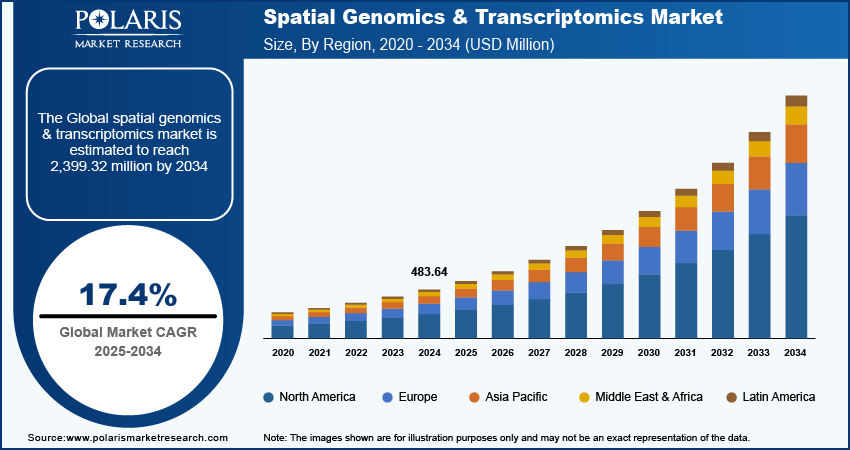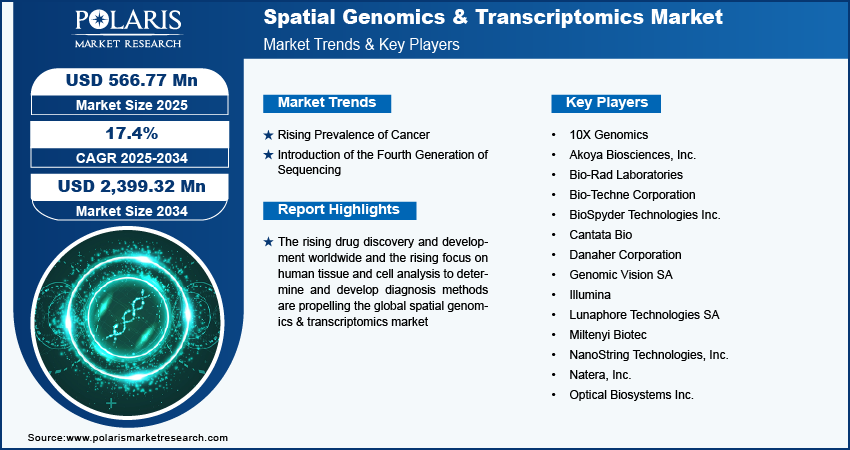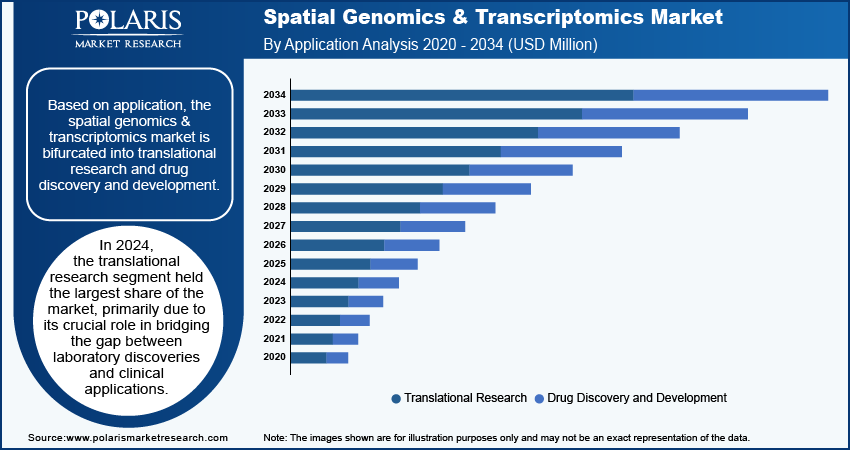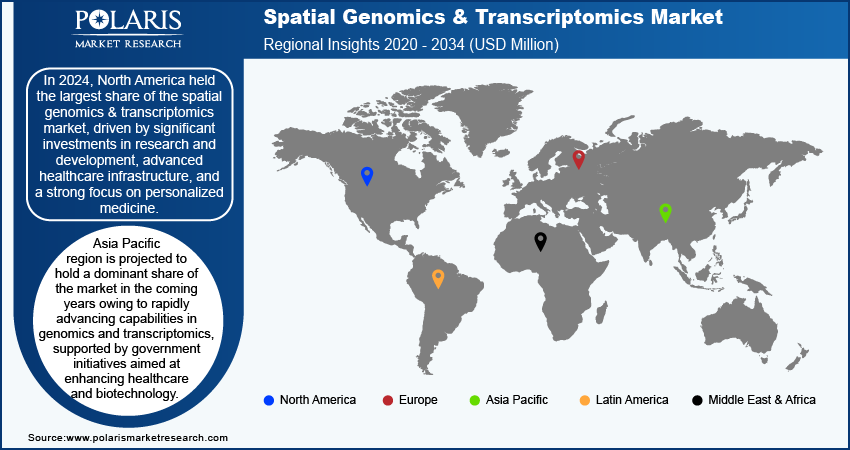
Spatial Genomics & Transcriptomics Market Size, Share, Trends, Industry Analysis Report: By Technique, Product (Instrument, Consumables, and Software), Application, End User, and Region; Market Forecast, 2025 - 2034
- Published Date:Nov-2024
- Pages: 119
- Format: PDF
- Report ID: PM5203
- Base Year: 2024
- Historical Data: 2020-2023
Spatial Genomics & Transcriptomics Market Outlook
Spatial genomics & transcriptomics market size was valued at USD 483.64 million in 2024. The market is anticipated to grow from USD 566.77 million in 2025 to USD 2,399.32 million by 2034, exhibiting a CAGR of 17.4% during the forecast period.
Spatial Genomics & Transcriptomics Market Overview
Spatial genomics focuses on the spatial organization of genes within tissues, providing insights into gene expression patterns and their relationship to disease states. This approach allows researchers to visualize and quantify gene activity in situ, enhancing the understanding of tissue heterogeneity and cellular interactions. Similarly, spatial transcriptomics combines traditional transcriptomic analysis with spatial information, enabling the profiling of gene expression at a single-cell resolution. This capability is crucial for studying the tumor microenvironment, where cellular interactions play a pivotal role in cancer progression.

To Understand More About this Research: Request a Free Sample Report
The rising drug discovery and development worldwide is propelling the global spatial genomics & transcriptomics market. Spatial genomics techniques reveal how different tissues respond to drugs at the molecular level, helping to predict efficacy and resistance mechanisms. This information is critical for optimizing drug development strategies. Therefore, as drug discovery and development spurs, the demand for spatial genomics & transcriptomics also increases.
The rising focus on human tissue and cell analysis to determine and develop diagnosis methods and cures is positively influencing the global spatial genomics & transcriptomics market. For instance, in February 2024, DNAnexus, a cloud-based platform that provides tools for managing and analyzing data to help researchers and healthcare professionals, closed a deal with Curio Bioscience to effectively streamline spatial transcriptomics data analysis and enhance accessibility to the tissues and species dataset.
Spatial Genomics & Transcriptomics Market Driver Analysis
Rising Prevalence of Cancer
The rising prevalence of cancer is fostering the spatial genomics & transcriptomics market. According to the World Health Organization, over 35 million new cancer cases are predicted in 2050, a 77% increase from the estimated 20 million cases in 2022. Cancer is highly heterogeneous, meaning that even within a single tumor, there can be a wide variety of cell types with different genetic and phenotypic characteristics. Spatial genomics and transcriptomics enable researchers to study the spatial distribution of these cell types, providing insights into how tumor heterogeneity influences growth, metastasis, and response to treatment.
Introduction of the Fourth Generation of Sequencing
The introduction of the fourth generation of sequencing is significantly boosting the spatial genomics & transcriptomics market. Fourth-generation sequencing technology has reduced the cost of genomic analyses. More affordable sequencing enables broader adoption of spatial genomics and transcriptomics techniques in both research and clinical settings, making it accessible for a wider range of studies, particularly those focused on cancer and other complex diseases. Additionally, fourth-generation sequencing often includes advanced multiplexing techniques, enabling the simultaneous analysis of multiple samples or conditions. This feature enhances the efficiency of experiments, facilitating large-scale studies that incorporate spatial genomics and transcriptomics.
Spatial Genomics & Transcriptomics Market Restraining Factors
High Costs and Complex Data Analysis
The advanced technologies and equipment required for spatial genomics and transcriptomics are expensive. This limits accessibility for smaller laboratories and institutions, slowing down widespread adoption. Furthermore, the data generated from spatial omics techniques are vast and complex. Analyzing this data requires advanced computational tools and bioinformatics expertise, which may not be readily available in all research settings, thereby hampering the market.

Spatial Genomics & Transcriptomics Market Segment Analysis
By Technique Analysis
Spatial Transcriptomics Segment is Expected to Witness the Highest Growth
Spatial transcriptomics is projected to dominate the market in the coming years. This growth stems from its ability to provide rich information about gene expression at a cellular level while retaining spatial information, which is crucial for understanding developmental biology and disease progression. Furthermore, ongoing technological innovations, such as enhanced imaging and multiplexing capabilities, are making spatial transcriptomics more accessible and efficient. Researchers are increasingly drawn to this approach for its potential to unravel the complexities of gene regulation and interaction, particularly in fields including oncology and neurology. Spatial transcriptomics is set to become a foundation in future research and therapeutic strategies as these technologies evolve and demonstrate their value in clinical applications.
By Application Analysis
Translational Research Segment Held the Significant Market Revenue Share in 2024
In 2024, the translational research segment held the largest share of the market, primarily due to its crucial role in bridging the gap between laboratory discoveries and clinical applications. The integration of spatial genomics and transcriptomics into translational research enhances the ability to understand disease mechanisms in a spatial context, thereby facilitating the identification of new biomarkers and therapeutic targets. Furthermore, funding from the government and private sectors has significantly increased, supporting translational research initiatives that aim to accelerate the development of personalized medicine. This inflow of resources enables researchers to leverage advanced technologies, ultimately enhancing the success rates of clinical trials and improving patient outcomes.

Regional Insights
North America Region Registered the Largest Share of Market in 2024
In 2024, North America held the largest share of the spatial genomics & transcriptomics market, driven by significant investments in research and development, advanced healthcare infrastructure, and a strong focus on personalized medicine. The US emerged as the dominant country in this region, benefiting from its robust biotechnology sector and numerous leading research institutions that prioritize innovative technologies. The presence of major pharmaceutical companies and extensive funding from both government and private sources further fuel advancements in genomic and transcriptomic research. Furthermore, the increasing prevalence of cancer and other complex diseases in North America amplifies the demand for technologies that provide detailed insights into disease mechanisms, thereby enhancing the region's growth trajectory.
Asia Pacific is also projected to hold a dominant share of the market in the coming years. Countries such as China and India are rapidly advancing their capabilities in genomics and transcriptomics, supported by substantial government initiatives aimed at enhancing healthcare and biotechnology. The rising prevalence of chronic diseases in these countries drives the need for innovative diagnostic and therapeutic approaches. Additionally, the increasing number of collaborations between academic institutions and industry players in Asia Pacific fosters a conducive environment for technological advancements and research breakthroughs, thereby driving demand for genomics & transcriptomics.

Key Market Players & Competitive Insights
Prominent market players are investing heavily in research and development in order to expand their offerings, which will help the genomics & transcriptomics market grow even more. Market participants are also undertaking a variety of strategic activities to expand their global footprint, with important market developments including innovative launches, international collaborations, higher investments, and mergers and acquisitions between organizations. To expand and survive in a more competitive and rising market environment, the genomics & transcriptomics market must offer innovative solutions.
The genomics & transcriptomics market is fragmented, with the presence of numerous global and regional market players. Major players in the genomics & transcriptomics market include 10X Genomics; Akoya Biosciences, Inc.; Bio-Rad Laboratories; Bio-Techne Corporation; BioSpyder Technologies Inc.; Cantata Bio; Danaher Corporation; Genomic Vision SA; Illumina; Lunaphore Technologies SA; Miltenyi Biotec; NanoString Technologies, Inc.; Natera, Inc.; and Optical Biosystems Inc.
Major Players in Global Spatial Genomics & Transcriptomics Market
- 10X Genomics
- Akoya Biosciences, Inc.
- Bio-Rad Laboratories
- Bio-Techne Corporation
- BioSpyder Technologies Inc.
- Cantata Bio
- Danaher Corporation
- Genomic Vision SA
- Illumina
- Lunaphore Technologies SA
- Miltenyi Biotec
- NanoString Technologies, Inc.
- Natera, Inc.
- Optical Biosystems Inc.
Recent Developments in Industry
May 2024: 10x Genomics introduced “Protein Expression Assay & Visium CytAssist Gene” commercially to enhance the potential of Visium CytAssist spatial analysis.
May 2024: Akoya Biosciences, a spatial biology firm, joined forces with NeraCare to produce melanoma tests, aiming to design skin cancer assays.
April 2023, Bio-Techne collaborated with Lunaphore to design and develop the world’s first automated spatial omics multi-workflow.
Spatial Genomics & Transcriptomics Report Coverage
The spatial genomics & transcriptomics market report emphasizes key regions across the globe to provide a better understanding of the product to the users. The report also provides market insights into recent developments and trends and analyzes the technologies that are gaining traction around the globe. Furthermore, the report covers an in-depth qualitative analysis pertaining to various paradigm shifts associated with the transformation of these solutions.
The report provides a detailed analysis of the market while focusing on various key aspects such as competitive analysis, technique, product, application, end user, and their futuristic growth opportunities.
Spatial Genomics & Transcriptomics Report Segmentation
By Technique Outlook (Revenue, USD Million, 2020 - 2034)
- Spatial Genomics
- Immunohistochemistry (IHC)
- In Situ Hybridization
- Sequencing Techniques
- Microscopy based RNA imaging
- Other Spatial Genomics Techniques
- Spatial Transcriptomics
- Immunohistochemistry (IHC)
- In Situ Hybridization
- Sequencing Techniques
- Other Spatial Transcriptomics Techniques
By Product Outlook (Revenue, USD Million, 2020 - 2034)
- Instruments
- Consumables
- Software
By Application Outlook (Revenue, USD Million, 2020 - 2034)
- Translational Research
- Drug Discovery and Development
By End User Outlook (Revenue, USD Million, 2020 - 2034)
- Academic Research Institutes
- Contract Research Organizations
- Pharmaceutical and Biotechnology Companies
By Region Outlook (Revenue, USD Million, 2020 - 2034)
- North America
- US
- Canada
- Europe
- Germany
- France
- UK
- Italy
- Spain
- Netherlands
- Russia
- Rest of Europe
- Asia Pacific
- China
- Japan
- India
- Malaysia
- South Korea
- Indonesia
- Australia
- Rest of Asia Pacific
- Middle East & Africa
- Saudi Arabia
- UAE
- Israel
- South Africa
- Rest of Middle East & Africa
- Latin America
- Mexico
- Brazil
- Argentina
- Rest of Latin America
Spatial Genomics & Transcriptomics Market Report Scope
|
Report Attributes |
Details |
|
Market Size Value in 2025 |
USD 566.77 million |
|
Revenue Forecast in 2034 |
USD 2,399.32 million |
|
CAGR |
17.4% from 2025 to 2034 |
|
Base Year |
2024 |
|
Historical Data |
2020 – 2023 |
|
Forecast Period |
2025 – 2034 |
|
Quantitative Units |
Revenue in USD million and CAGR from 2025 to 2034 |
|
Segments Covered |
|
|
Regional Scope |
|
|
Competitive Landscape |
Spatial Genomics & Transcriptomics Industry Trend Analysis (2024) Company Profiles/Industry participants profiling includes company overview, financial information, product/service benchmarking, and recent developments |
|
Report Format |
PDF + Excel |
|
Customization |
Report customization as per your requirements with respect to countries, regions, and segmentation. |
FAQ's
The global spatial genomics & transcriptomics market size was valued at USD 483.64 million in 2024 and is projected to grow to USD 2,399.32 million by 2034.
The global market registers a CAGR of 17.4% during the forecast period.
North America had the largest share of the global market in 2024.
The key players in the market are 10X Genomics; Akoya Biosciences, Inc.; Bio-Rad Laboratories; Bio-Techne Corporation; BioSpyder Technologies Inc.; Cantata Bio; Danaher Corporation; Genomic Vision SA; Illumina; Lunaphore Technologies SA; Miltenyi Biotec; NanoString Technologies, Inc.; Natera, Inc.; and Optical Biosystems Inc.
The spatial genomics segment is projected for significant growth in the global market.
The translational research segment dominated the spatial genomics & transcriptomics market in 2024.
